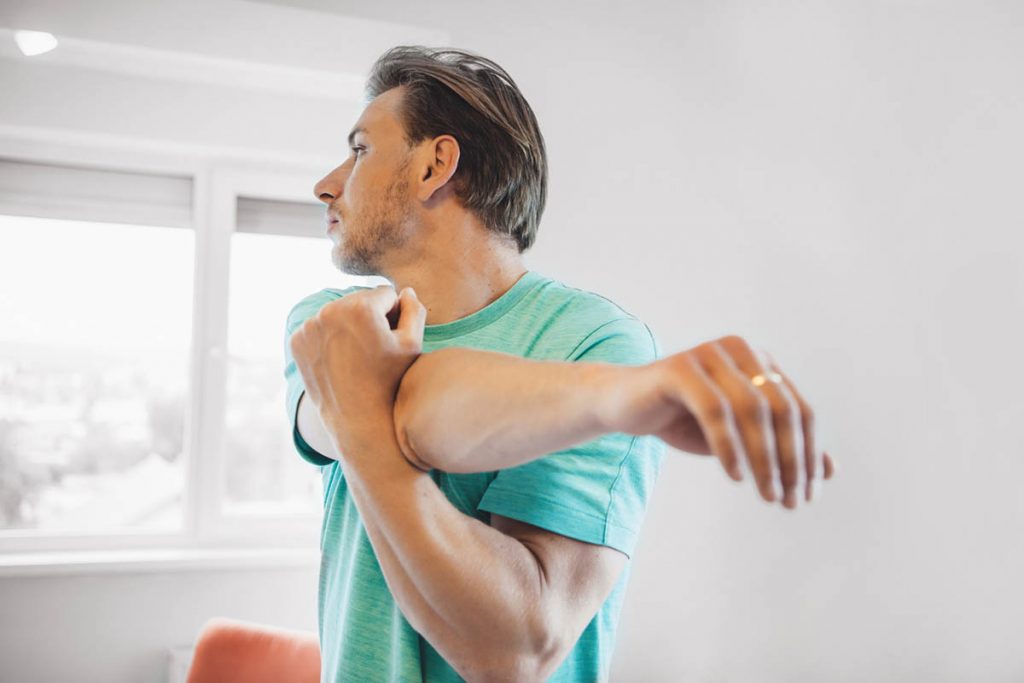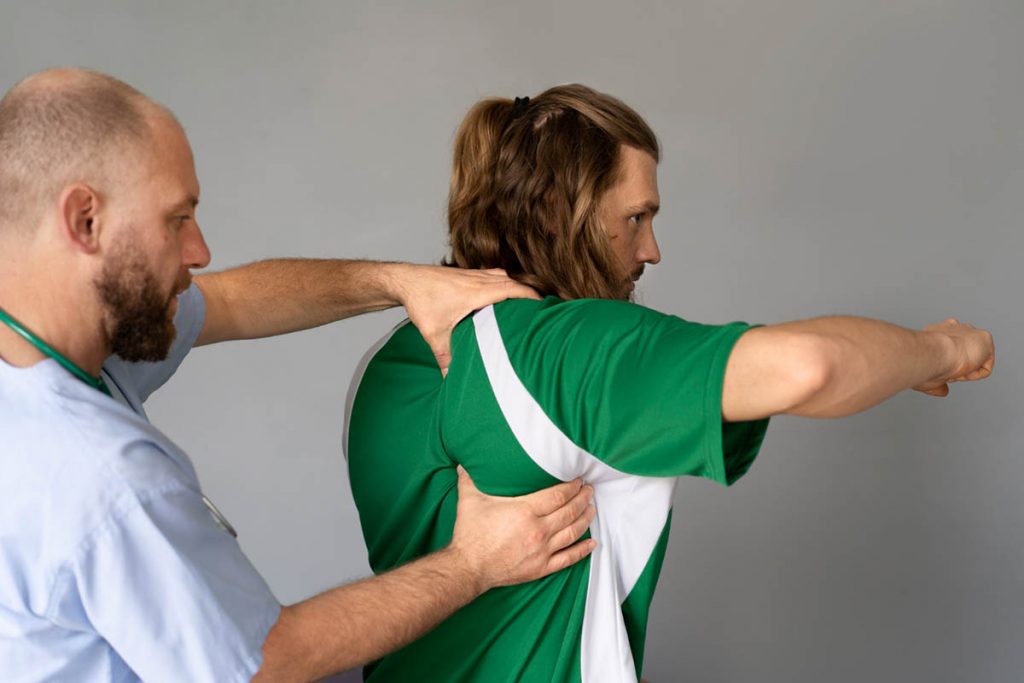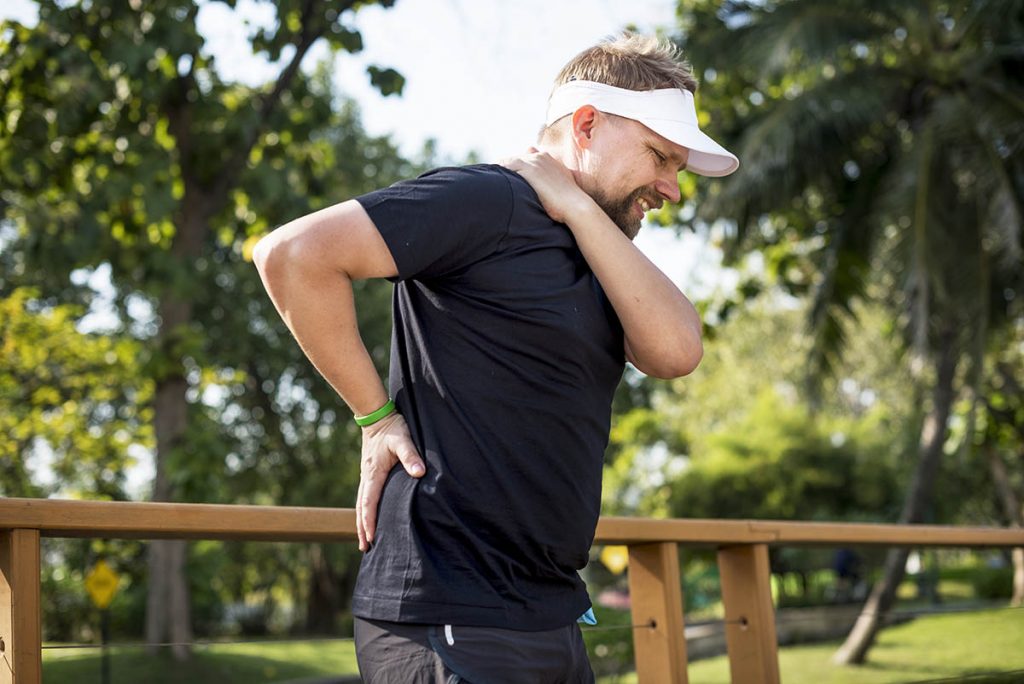Shoulder pain is a common issue, affecting 18 to 26 percent of adults. According to research, shoulder pain is a common symptom affecting a significant percentage of adults. Depending on the type of shoulder injury or pain, exercises and manual therapy have been found effective in reducing discomfort. This discomfort can stem from a variety of causes, including overuse, injury, or conditions like arthritis and adhesive capsulitis. Engaging in regular shoulder conditioning exercises is crucial for preventing and managing shoulder function. These exercises for shoulder pain aim to strengthen and lengthen the shoulder muscles, enhancing shoulder motion and alleviating discomfort.
Common Shoulder Injuries And Conditions That Lead To Pain
Shoulder pain can result from numerous conditions and injuries, such as:
- Rotator Cuff Injuries: Tears or inflammation in the rotator cuff muscles and tendons.
- Bursitis: Inflammation of the bursa, a fluid-filled sac that cushions the shoulder joint.
- Tendinitis: Inflammation of the tendons around the shoulder joint.
- Arthritis: Degeneration of the shoulder joint, causing pain and stiffness.
- Frozen Shoulder: A condition that leads to pain and restricted movement in the shoulder.
Benefits Of Shoulder Conditioning Exercises
Engaging in shoulder conditioning exercises offers several benefits, including:
- Pain Relief: Strengthening and stretching the muscles around the shoulder can reduce pain.
- Improved Flexibility: Regular exercises enhance the wide range of motion, making daily activities easier.
- Injury Prevention: Strengthened muscles and tendons are less prone to injuries.
- Enhanced Posture: Exercises can improve posture, reducing strain on the shoulder joint.
Shoulder Pain Exercises For Conditioning

Pendulum
- Main muscles worked: Deltoids, rotator cuff muscles
- Equipment needed: None
- Repetitions: 10-15
- Days Per Week: 3-4
- Step-by-step directions:
- Stand with your non-injured hand resting on a table for support.
- Let your injured arm hang down freely.
- Gently swing your arm in small circular motions.
- Perform for 1-2 minutes.
- Tips: Keep movements gentle and avoid pain.
Crossover Arm Stretch
- Main muscles worked: Posterior deltoid, rotator cuff muscles
- Equipment needed: None
- Repetitions: 3-5
- Days Per Week: 4-5
- Step-by-step directions:
- Stand or sit with your back straight.
- Raise your right arm to shoulder height and bring it across your body.
- Use your left hand to press your right arm closer to your chest.
- Hold for 15-30 seconds and repeat on the other side.
- Tips: Avoid twisting your torso; focus on stretching the shoulder.
Passive Internal Rotation
- Main muscles worked: Subscapularis
- Equipment needed: Stick or towel
- Repetitions: 10-15
- Days Per Week: 3-4
- Step-by-step directions:
- Hold a stick behind your back with both hands.
- Use your non-injured arm to push the injured arm up towards the shoulder blade.
- Hold for 15-30 seconds.
- Tips: Move slowly and gently to avoid discomfort.
Passive External Rotation
- Main muscles worked: Infraspinatus, teres minor
- Equipment needed: Exercise band or towel
- Repetitions: 10-15
- Days Per Week: 3-4
- Step-by-step directions:
- Lie on your back with your arms at your sides.
- Hold a light weight with both hands.
- Use the non-injured arm to push the injured arm away from the body in a circular motion.
- Maintain the arm position and hold for 15-30 seconds.
- Tips: Keep the movements slow and controlled.
Sleeper Stretch
- Main muscles worked: Infraspinatus, teres minor
- Equipment needed: None
- Repetitions: 3-5
- Days Per Week: 4-5
- Step-by-step directions:
- Lie on your side with the injured shoulder on the bottom.
- Bend the injured arm at a 90-degree angle.
- Use the non-injured arm to gently press the injured arm towards the floor.
- Hold for 15-30 seconds.
- Tips: Avoid pressing too hard; focus on a gentle stretch.
Standing Row
- Main muscles worked: Rhomboids, trapezius
- Equipment needed: Exercise band
- Repetitions: 10-15
- Days Per Week: 3-4
- Step-by-step directions:
- Attach a resistance band to a stable object at waist height.
- Hold the ends of the band in each hand.
- Pull the band towards your body, squeezing your shoulder blades together to improve shoulder function and body flexibility.
- Hold for a second, then slowly release.
- Tips: Keep your back straight and avoid shrugging your shoulders. Perform this exercise with light dumbbells to avoid unnecessary strain.
External Rotation with Arm Abducted 90°

- Main muscles worked: Infraspinatus, teres minor
- Equipment needed: Resistance band
- Repetitions: 10-15
- Days Per Week: 3-4
- Step-by-step directions:
- Attach a resistance band to a stable object at waist height.
- Hold the end of the band with your injured arm, which should be raised to shoulder height and bent at a 90-degree angle.
- Rotate your arm outward, keeping your elbow in place.
- Hold for a second, then slowly return.
- Tips: Avoid moving your upper arm; focus on the rotation. Perform this exercise as part of a 10-minute routine for comprehensive shoulder care. These shoulder blade pain relief exercises can be part of a comprehensive routine to address various shoulder issues.
Internal Rotation
- Main muscles worked: Subscapularis
- Equipment needed: Resistance band
- Repetitions: 10-15
- Days Per Week: 3-4
- Step-by-step directions:
- Attach a resistance band to a stable object at waist height.
- Hold the end of the band with your injured arm.
- Rotate your arm inward, keeping your elbow in place.
- Hold for a second, then slowly return.
- Tips: Keep your elbow close to your body during the exercise.
External Rotation
- Main muscles worked: Infraspinatus, teres minor
- Equipment needed: Resistance band
- Repetitions: 10-15
- Days Per Week: 3-4
- Step-by-step directions:
- Attach a resistance band to a stable object at waist height.
- Hold the end of the band with your injured arm.
- Rotate your arm outward, keeping your elbow in place.
- Hold for a second, then slowly return.
- Tips: Maintain a steady pace and controlled movements.
Elbow Flexion
- Main muscles worked: Biceps brachii
- Equipment needed: Dumbbells or resistance band
- Repetitions: 10-15
- Days Per Week: 3-4
- Step-by-step directions:
- Stand with your feet shoulder-width apart, holding a dumbbell or resistance band.
- Slowly curl your arm towards your shoulder.
- Hold for a second, then lower it back down.
- Tips: Keep your upper arm stationary and focus on the movement of your forearm.
Elbow Extension
- Main muscles worked: Triceps brachii
- Equipment needed: Dumbbells or resistance band
- Repetitions: 10-15
- Days Per Week: 3-4
- Step-by-step directions:
- Stand with your feet shoulder-width apart, holding a dumbbell or resistance band.
- Extend your arm above your head.
- Slowly lower your forearm behind your head.
- Hold for a second, then raise it back up.
- Tips: Keep your upper arm stationary and focus on the movement of your forearm.
Trapezius Strengthening
- Main muscles worked: Trapezius
- Equipment needed: Dumbbells
- Repetitions: 10-15
- Days Per Week: 3-4
- Step-by-step directions:
- Stand with your feet shoulder-width apart, holding dumbbells in each hand.
- Shrug your shoulders upwards.
- Hold for a second, then slowly lower them back down.
- Tips: Avoid rolling your shoulders; focus on lifting them straight up.
Scapula Setting
- Main muscles worked: Rhomboids, trapezius
- Equipment needed: None
- Repetitions: 10-15
- Days Per Week: 3-4
- Step-by-step directions:
- Stand with your back straight.
- Squeeze your shoulder blades together, keeping the arm position steady.
- Hold for a second, then release.
- Tips: Ensure you keep your shoulders relaxed and avoid lifting them towards your ears. Focus on squeezing your shoulder blades together smoothly to improve body structures.
Scapular Retraction/Protraction
- Main muscles worked: Rhomboids, serratus anterior
- Equipment needed: Resistance band
- Repetitions: 10-15
- Days Per Week: 3-4
- Step-by-step directions:
- Attach a resistance band to a stable object at waist height.
- Hold the ends of the band in each hand.
- Pull the band towards you, bringing your shoulder blades together (retraction).
- Slowly extend your arms, pushing the band away from you (protraction).
- Tips: Maintain a straight back and control the movement throughout the exercise.
Bent-Over Horizontal Abduction
- Main muscles worked: Posterior deltoid, rhomboids
- Equipment needed: Dumbbells
- Repetitions: 10-15
- Days Per Week: 3-4
- Step-by-step directions:
- Stand with your feet shoulder-width apart and bend forward at the waist, keeping your back straight.
- Hold a dumbbell in each hand with your arms hanging straight down.
- Lift your arms out to the side until they are parallel to the floor.
- Hold for a second, then slowly lower them back down.
- Tips: Avoid swinging the weights; focus on lifting with control.
Internal and External Rotation
- Main muscles worked: Rotator cuff muscles
- Equipment needed: Resistance band
- Repetitions: 10-15
- Days Per Week: 3-4
- Step-by-step directions:
- Attach a resistance band to a stable object at waist height.
- Hold the end of the band with your injured arm.
- For internal rotation, rotate your arm inward towards your body.
- For external rotation, rotate your arm outward away from your body.
- Tips: Keep your elbow at a 90-degree angle and close to your body.
External Rotation (With Weights)
- Main muscles worked: Infraspinatus, teres minor
- Equipment needed: Dumbbells
- Repetitions: 10-15
- Days Per Week: 3-4
- Step-by-step directions:
- Lie on your side with the injured arm on top, holding a dumbbell.
- Keep your elbow bent at a 90-degree angle.
- Rotate your arm outward, lifting the dumbbell towards the ceiling.
- Hold for a second, then slowly lower it back down.
- Tips: Perform the exercise slowly and with controlled movements to enhance body flexibility and reduce shoulder pain.
Internal Rotation (With Weights)
- Main muscles worked: Subscapularis
- Equipment needed: Dumbbells
- Repetitions: 10-15
- Days Per Week: 3-4
- Step-by-step directions:
- Lie on your side with the injured arm on the bottom, holding a dumbbell.
- Keep your elbow bent at a 90-degree angle.
- Rotate your arm inward, lifting the dumbbell towards your abdomen.
- Hold for a second, then slowly lower it back down.
- Tips: Focus on smooth and controlled movements to avoid strain. Remember to take deep breaths during the exercise to enhance your performance.
Start Your Recovery with Expert Care at Land And Sea Physical Therapy

At Land and Sea Physical Therapy, we understand the impact shoulder pain can have on your everyday activities. Our team of experienced physical therapists is dedicated to helping you recover through personalized exercise programs and hands-on treatments. Whether you’ve sustained a shoulder injury or are experiencing chronic pain, we provide comprehensive care tailored to your needs. Consult a healthcare professional to ensure the exercise band exercises are appropriate for your condition. A treatment plan will be developed based on your specific needs to ensure the best recovery. Schedule an appointment with us today and start your journey to pain-free living.
Conclusion
Shoulder pain can be debilitating, but with the right conditioning exercises, including physical therapy exercises for shoulder pain, you can alleviate discomfort and improve your shoulder’s strength and flexibility. This shoulder conditioning program is designed to help those who have sustained a shoulder injury or undergone surgery. However, it is important to ensure that the program is safe and effective for you by performing it under your doctor’s supervision. In case of a medical emergency, contact a healthcare provider immediately. Request Appointment at Land and Sea PT to ensure your exercise program is tailored to your needs and performed correctly under professional supervision.
FAQs
What is the main cause of shoulder pain?
Shoulder pain is commonly caused by conditions such as rotator cuff injuries, bursitis, tendinitis, arthritis, and frozen shoulder. Overuse, repetitive movements, and sudden injuries can also lead to shoulder pain.
How do you prevent shoulder pain?
Preventing shoulder pain involves regular exercise to strengthen and stretch the shoulder muscles, maintaining good posture, avoiding repetitive overhead activities, and taking breaks during prolonged activities to reduce strain on the shoulders.
Can shoulder pain be treated?
Yes, shoulder pain can often be treated effectively with a combination of physical therapy, exercises, and, in some cases, medication or surgery. Strengthening and mobility exercises can reduce pain and improve joint flexibility, helping you return to normal activities.
Start your recovery with expert care at Land and Sea Physical Therapy. Schedule your appointment today!

